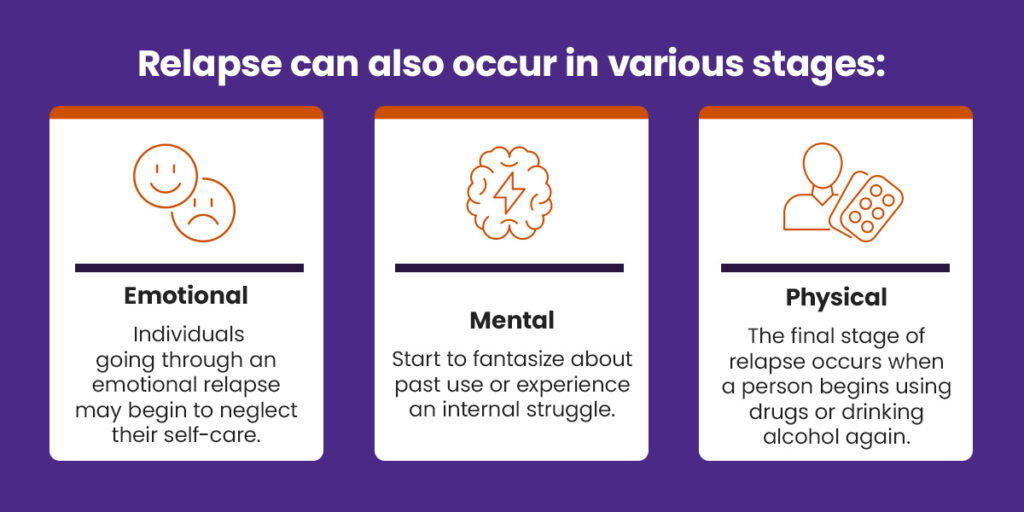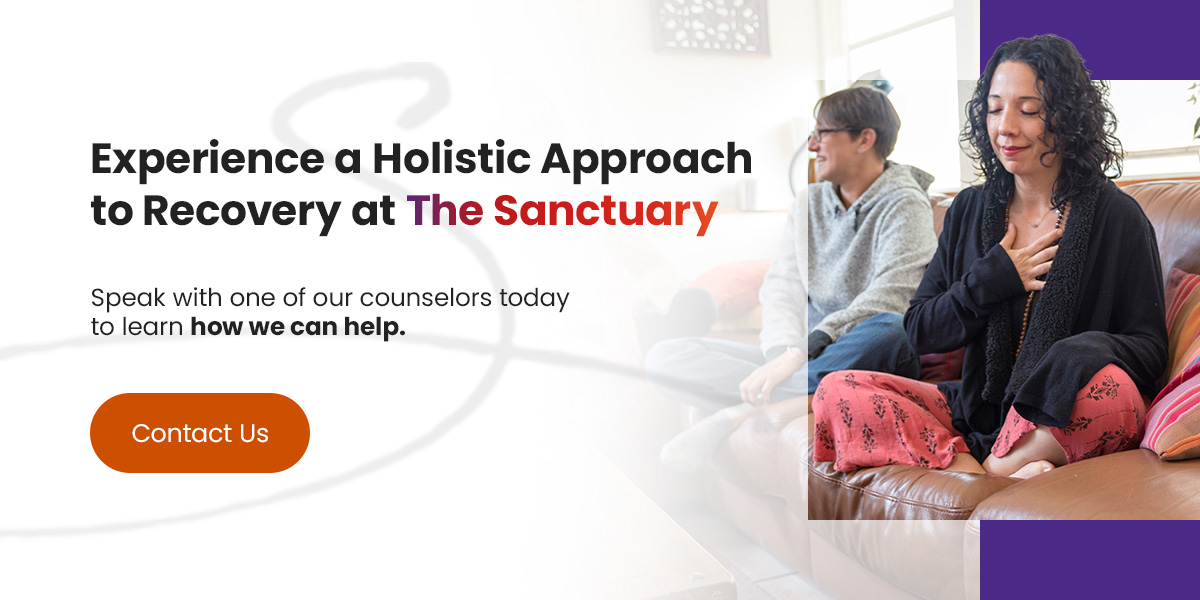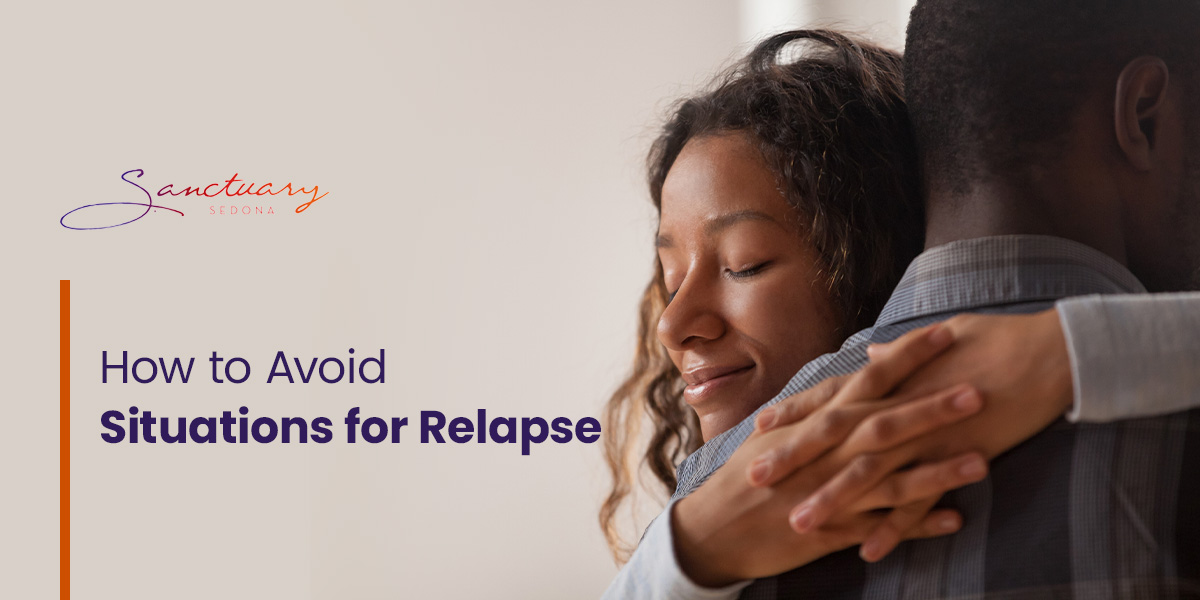How to Avoid Situations for Relapse
Relapse, or returning to chronic use of substances, is very common. An estimated 40% to 60% of individuals with substance use disorder (SUD) experience relapse even after treatment. It’s important to note that relapse is not and should not be considered a failure on your journey to recovery. Addiction is a disease that impacts how your brain functions, which can make controlling inhibitions, cravings and behavior extremely challenging.
Breaking the cycle of addiction is a lifelong journey. It requires ongoing support, setting boundaries, learning coping skills and gaining an understanding of what can lead to relapse. If you struggle with relapse triggers and stressors, know that you can still lead a sober life. We’ve outlined some of the most common situations that cause relapse and how to prevent it.
What Is Relapse?
Relapse refers to a return to substance use after abstaining for a period of time. In addiction recovery, relapse occurs when an individual continues their previous levels of use of drugs or alcohol while on a journey to reduce or avoid use altogether. There’s an important distinction to make between a relapse and a lapse.
A lapse is a temporary return to using where the individual gets back on track with their goals. For example, a person who has been sober from drinking alcohol may experience a minor slip-up, such as having a few sips of an alcoholic drink, but return to their sobriety goal the next day. This situation would be considered a lapse if the person regains sobriety and remains dedicated to recovery. A lapse can even be accidental.
A relapse implies more of an active addiction in which the individual returns to heavy and frequent use. A relapse may also include an increase in negative behaviors, such as secrecy, dissociation, emotional detachment and isolation. Relapse is particularly common within the first 90 days of addiction recovery, as individuals often have a higher sensitivity to stress. Despite the stigma and stereotypes surrounding relapse, it does not represent weakness or a “failed” recovery. Overcoming addiction requires significant behavioral and life changes that take time to maintain.
High-Risk Situations for Relapse
Every person with addiction experiences the disease differently. This means you’ll have different stressors and risks for relapse than others. These risks occur in three different categories, including:
- Low risk: Includes situations where you are not likely to relapse
- Moderate risk: Includes situations where you may be likely to use drugs or alcohol
- High risk: Includes situations where you are highly likely to use a substance
The specifics of these categories are unique to every individual with addiction. Many common internal and external triggers can heighten the urge to use, including:
- Social pressure: Peer pressure from family members or old friends who still use substances is a common risk factor for relapse. Individuals in recovery may be tempted to engage with “controlled” use with others for special occasions to avoid feeling isolated. Being around others who refer to past occurrences of using drugs or alcohol as “good old times” can also be a trigger.
- Emotional states: Emotions like anxiety, anger, grief, depression, guilt, sadness and loneliness can cause people in addiction recovery to turn to substances again. Alternatively, excitement and high levels of confidence can cause individuals to feel a false sense of control or doubt the severity of their addiction.
- Interpersonal conflict: Stress from breakups, divorce and tension with family members or coworkers can trigger the urge to use. A lack of social and emotional support or financial difficulties can also be problematic during recovery.
- Physical symptoms: Physical discomfort can make it challenging to resist using substances, such as experiencing withdrawal symptoms, pain from injuries or complications from illness or medical conditions.
- Environmental cues: Visiting locations or living situations where past substance use occurred can be a trigger for relapse, as being in these environments can set off mental cues of the comfort of using. Attending events or parties where alcohol or drugs are present can also test one’s self-control.
Other risk factors can include having an untreated physical or mental illness, engaging in other addictive behaviors like gambling and a belief that the substance brings positive effects, such as decreased anxiety. While this is certainly not an exhaustive list of reasons for relapse, they may help you understand that your experiences are not uncommon.
Stages of Relapse
Whether you’ve experienced relapse yourself or watched someone you love go through it, it’s vital to understand that it looks different for everyone. For many, the relapse process begins long before one decides to use substances again. In addition to triggers, relapse can also occur in various stages:

- Emotional: Individuals going through an emotional relapse may begin to neglect their self-care, including proper sleep and nutrition, and become more isolated from loved ones. They may also start reducing their attendance at AA meetings or group therapy sessions. Failing to reach out for social support or stopping medication prescribed for their addiction can be early warning signs. At this stage, most individuals may not have even considered using substances yet.
- Mental: Those at the mental stage of relapse might start to fantasize about past use or experience an internal struggle about sticking to their recovery goals. During this stage, individuals begin to think about using and may revert to old habits like lying or imagining their self-efficacy is stronger than it really is.
- Physical: The final stage of relapse occurs when a person begins using drugs or drinking alcohol again. It’s very difficult to stop once they’re at this stage, but it’s not impossible to overcome.
How to Cope With High-Risk Situations
Because it’s not always possible to avoid such situations, learning to cope with stress and triggers is one of the most powerful tools against the desire to use. In addition to continuing professional treatment for addiction, it’s important to develop a relapse prevention plan that works for your unique needs and lifestyle. A relapse prevention plan will help you respond to high-risk situations in a healthy, responsible way.
Here are some tips on how to avoid relapse:
- Build a recovery circle: The importance of emotional, social and professional support during recovery cannot be overstated. Family support can be very helpful for sustaining sobriety. However, trusted friends can also help you avoid high-risk situations. Support groups, counselors and other health professionals are invaluable after a lapse or relapse.
- Identify triggers: Developing a proactive mindset is key to preventing future relapses. Outline your personal triggers and high-risk situations, as this can help you anticipate and prepare. The more you educate yourself and your loved ones about your challenges, the better chance you have of managing them.
- Follow DEADS: When in doubt, follow the DEADS acronym that individuals with addiction use to stay on the path to recovery. The acronym stands for delay, escape, avoid, distract and substitute. When you experience cravings to use substances, try to follow these steps to get out of a high-risk situation. Delay your cravings, escape the situation, avoid risky events, distract yourself or substitute substances for a positive reward.
- Be patient: A key part of a relapse prevention plan is staying motivated to reach your sobriety goal. Be patient with yourself as you take on this challenging journey. Remember, there is no shame in relapsing. However, the sooner you intervene after a relapse, the easier it can be to get back on track. It’s never too late to seek professional help, even if you have done so in the past. Some people benefit from returning to addiction treatment programs several times on their recovery path or trying a new treatment method altogether.
Experience a Holistic Approach to Recovery at The Sanctuary
If you’ve attended an addiction treatment program and experienced a relapse, it does not mean you have failed. Relapsing can indicate a need for treatment adjustments at a life rejuvenation center. At The Sanctuary at Sedona, we can help you see things from a fresh perspective with alternative treatment modalities and life skill classes.
We offer an integrative, holistic approach to addiction recovery. Our residential treatment program includes indigenous wisdom traditions and traditional, evidence-based therapies to help you end the cycle of substance addiction. Our practitioners and clinical team take a collaborative approach to your healing by developing a personalized treatment plan for your unique needs and addressing your entire well-being. Speak with one of our counselors today to learn how we can help.


